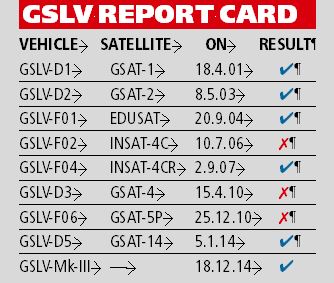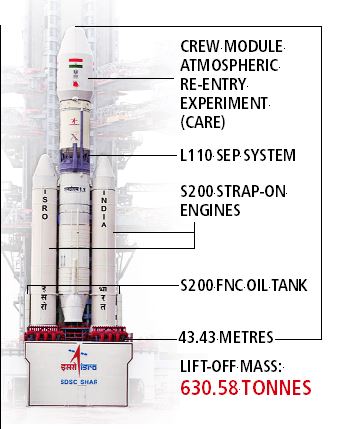Stay updated with the latest - Click here to follow us on Instagram
ISRO’s GSLV-Mark III: Promise of a leap
What the success of the LVM3-X/CARE mission and India’s new GSLV Mk-III space launcher means
 Indian Space Research Organisation’s GSLV-Mark III rocket lifts off during a test flight carrying CARE. (Source: PTI photo)
Indian Space Research Organisation’s GSLV-Mark III rocket lifts off during a test flight carrying CARE. (Source: PTI photo)
VITAL STATS
# 1,600 degrees Celsius is the temperature that the crew module withstood at re-entry into atmosphere
# Rs 155 crore was budget of experimental mission; Rs 15 crore was cost of crew module
# Over 3 tonne payload carried by the module, separated at 126 km altitude, plunged into sea
LAUNCH OF A MISSION
India’s extra-terrestrial ambitions have been shackled by the lack of a heavy launcher for deep space missions. The success of ISRO’s LVM3-X/CARE mission demonstrated the ability to put heavy satellites into orbit, and marked the first step towards sending humans into space. The GSLV Mk-III, India’s heaviest launch vehicle yet, lifted off from the Second Launch Pad of Satish Dhawan Space Centre in Sriharikota at 9.30 am Thursday.
RE-ENTRY TEST CLEAR
The launch marked the successful testing of the atmospheric re-entry of a crew module, which separated from the rocket 325 seconds after lift-off at an altitude of 126 km, and descended in ballistic mode, re-entering the Earth’s atmosphere (about 80 km above sea level) and splashing down into the Bay of Bengal 180 km from Indira Point, the southern tip of the Andaman and Nicobar Islands. The main parachute used by the module was 31 m in diameter, the largest ever made in India, and allowed splashdown at a velocity of around 7 m per second.
 THIS IS SIGNIFICANT
THIS IS SIGNIFICANT
Because this is the first time that ISRO has succeeded in returning a space crew module to Earth. All satellites it has launched so far, as well as the Chandrayaan and Mangalyaan spacecraft, are supposed to stay in space, and get destroyed there. Re-entry capability is key to sending a human into space. This is a complicated and dangerous manoeuvre; it is while re-entering the Earth’s atmosphere that the space shuttle Columbia was destroyed in 2003, killing seven astronauts, including Indian American Kalpana Chawla.
AFTER SPLASHDOWN
Indian Coast Guard ships were expected to retrieve the module and take it to Kamarajar port in Ennore near Chennai, from where it will be shifted to the Vikram Sarabhai Space Centre at Thiruvananthapuram for further study, which is expected to enhance understanding of the re-entry and parachute phases of the flight.
FOLLOWING SUCCESS
This was an experimental flight. Once ISRO masters the GSLV Mk-III, India can expect to save foreign exchange that it now spends to send heavy communication satellites through space agencies aboard, and also make money by sending up heavy satellites for other countries. The global space industry is worth $ 300 billion, and Antrix Corp Ltd, ISRO’s commercial arm, already earns revenue from its PSLV rockets.
MANNED SPACE MISSION
Is probably at least 10 years away. The GSLV Mk-III was launched with active S200 (solid) and L110 (liquid core) propulsive stages and a passive cryogenic stage (C25) with a dummy engine. The cryogenic engine, now under development at the Liquid Propulsion Systems Centre in Mahendragiri in Tamil Nadu’s Tirunelveli district, is likely to be ready in about two years. The launcher’s performance with a heavy third (cryogenic) engine on board will be key to attempting a manned mission or heavier satellite launches.
IN IMMEDIATE FUTURE
ISRO’s next launch is of the fourth satellite in the Indian Regional Navigational Satellites System (IRNSS) series in the first week of March 2015. Three of the seven satellites in the series have already been launched. IRNSS will put India in a select group of countries with their own navigation systems. US and Russia have global satnav systems, and China is in the process of upgrading its regional satnav to a global one.
 This was a very significant day in the history of the Indian space programme for the development of the advanced launch vehicle that could carry a 4-tonne class of communication satellite into orbit.
This was a very significant day in the history of the Indian space programme for the development of the advanced launch vehicle that could carry a 4-tonne class of communication satellite into orbit.
K Radhakrishnan, ISRO chairman
The powerful launch vehicle… will change our destiny in placing various spacecraft into communication orbits…
S Somnath, Project Director
Successful launch of GSLV Mk-III is yet another triumph of brilliance & hard work of our scientists. Congrats to them for the efforts. @isro
Narendra Modi, Prime Minister








